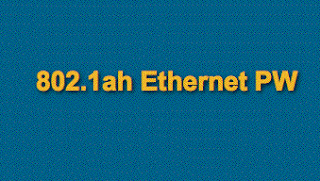Provider Backbone Bridging (PBB)
As
you can see, I'm writing about provider architectures lately. Last
week, I wrote about Bridging
and Provider Bridging where you can
read that the traditional bridging is not enough today for large
networks because service provider and cloud companies need more than
4096 VLAN. Therefore, Provider Bridging is an option because we can
address till 16 millions of networks with double VLAN tags. However,
Provider Bridging is not scalable due to
the fact that it needs big and expensive TCAM because customer MAC
addresses are saved by every router, even core and spine routers. As
a result, Provider Backbone Bridging (PBB)
is here to solve this problem.
Provider
Backbone Bridging is the standard 802.1.ah by IEEE and the main
different with regard to Provider Bridging is
the encapsulation method to hide customer MAC addresses to the
backbone instead of doubling tags. This is a great advantage because
we don't need expensive routers in the
backbone with big content-addressable memories (TCAM) for large
networks but spine and core routers speaking PBB. Therefore, inner
(customer) MAC addresses are encapsulated within
outer (Provider) MAC addresses which is useful for hiding customer
frames to the backbone.
 |
| Bridges, VLANs, Provider Bridges and Provider Backbone Bridges |
The
encapsulation technique is also called Overlay and
there are many technologies today that use this method to hide frames
and interconnect layer 2 networks. For
example, traditional VPNs are Network Overlays like OTV, VPLS
or LISP; We can configure Host Overlays as well like VXLAN, NVGRE or
STT; or even we can have a mix to make Hybrid Overlays. Anyway,
it's a good way to make
simple
and scalable networks without worrying about the underlying network
because Overlay Networks allow us to change, manage and deploy new
technologies quickly, although, sometimes, the architecture could
seem more complex and difficult to manage.
 |
| Overlay Networks |
PBB
implements intelligent bridging which is useful for layer 2
multipathing. Therefore,
while traditional networks had limited performance due to the fact
that traffic was North-South for web content, email, etc, flat
networks like CLOS networks, along with PBB, are more manageable and
scalable thanks to East-West alignment, which
offer better performance and reliability for server to server
communication, useful for cloud computing and
hadoop
architectures.
 |
| North-South and East-West traffic |
Multipathing
is a great feature for CLOS networks but although PBB uses
encapsulation in the data plane for hiding customer frames, it may
use Spanning Tree in the control plane for loop avoidance. This is a
big problem, I mean, if we use Spanning Tree (STP) in the control
plane, we'll have the same inherent problems than STP; nothing about
layer 2 multipathing, scalability problems, convergence delays,
North-South traffic, etc. Consequently, we can implement PBB-TE,
which is the 802.1Qay standard, PBB-EVPN over MPLS networks or even
SPB, which 802.1aq standard, for better performance, reliability and
real layer 2 multipathing.
Regards
my friends, this is going too fast, keep
studying my friend!










Commentaires
Enregistrer un commentaire